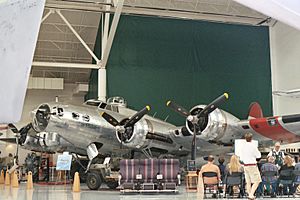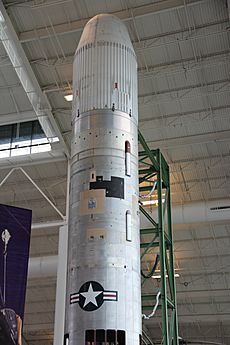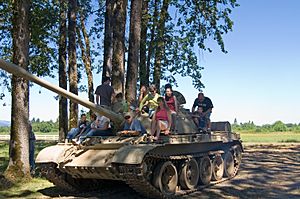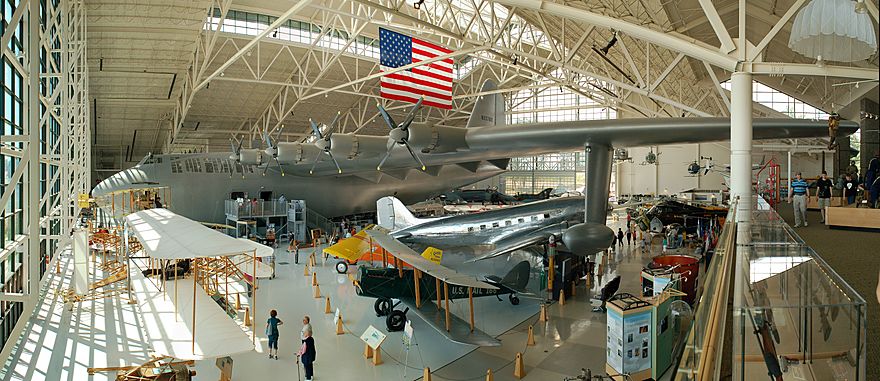- This page was last modified on 17 October 2025, at 10:18. Suggest an edit.
Evergreen Aviation & Space Museum facts for kids
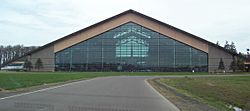 |
|
| Established | 1991 (as the Evergreen Museum) |
|---|---|
| Location | McMinnville, Oregon, United States |
| Type | Aerospace museum |
| Founder | Delford M. Smith and Michael King Smith |
The Evergreen Aviation & Space Museum is a super cool museum in McMinnville, Oregon. It's a non-profit place, which means it's run for the public good, not to make money. This museum is famous for its amazing collection of planes and spacecraft.
You can see the giant Hughes H-4 Hercules, also known as the Spruce Goose, here! There are also over fifty other aircraft, including military jets, civilian planes, and even drones. Plus, you'll find real spacecraft. The museum has four main parts: an aviation hall, a huge movie theater, a space technology hall, and even a water park!
The museum is located right across the highway from the old offices of Evergreen International Aviation. It's also near the McMinnville Municipal Airport.
Contents
How the Museum Started
The idea for the Evergreen Museum came from Michael King Smith. He was a former captain in the United States Air Force. His dad, Delford M. Smith, founded Evergreen International Aviation. The museum first opened in 1991. Back then, it was a small collection of old planes in a hangar.
The Spruce Goose Finds a Home
In March 1990, The Walt Disney Company decided to close its exhibit of the Spruce Goose in California. This huge, historic aircraft needed a new home. In 1992, the Evergreen Museum won the chance to host it! They planned to build a whole new museum around this amazing plane.
Taking the Spruce Goose apart began in August 1992. Its pieces traveled by ship up the Pacific Ocean and then by river to Dayton, Oregon. From there, trucks carried the parts to Evergreen International Aviation. The plane arrived in February 1993.
For the next eight years, many volunteers worked hard to restore the plane. They removed all the old paint, fixed worn parts, and repainted the entire aircraft. In September 2000, the main parts were ready. The body, wings, and tail were moved into the new museum building, which was still being built. Over the next year, crews put the wings and tail onto the body. Everything was ready for the museum's grand opening on June 6, 2001. The last piece was added on December 7, 2001.
Changing Names and Growing Bigger
The museum's name has changed a few times. It started as the Evergreen Museum. In 1994, it became the Evergreen AirVenture Museum. Then, in 1997, it was renamed the Captain Michael King Smith Evergreen Aviation Educational Center. This was to honor Michael King Smith, who sadly passed away in 1995.
In September 2006, work started on a new space museum building. It was designed to look just like the aviation museum. The museum had collected many space items and needed more room. The new building was finished in May 2008. It opened on June 6, 2008, exactly seven years after the aviation museum. In 2009, the museum joined the Smithsonian Affiliations program. This means it's connected to the famous Smithsonian museums!
Overcoming Challenges
Like many places, the museum faced some tough times financially. However, it always found a way to keep going. In April 2020, a company called The Stoller Group helped the museum get back on its feet. They bought some of the land around the museum and the water park. This helped the museum become financially stable again. The Stoller Group also started fixing up the museum and water park. They even plan to make the vineyard on the grounds bigger.
What You Can See at the Museum
As of 2025, there are two main exhibit buildings open to visitors.
The Aviation Center
This is the original building. The amazing Spruce Goose is the main attraction here! Other aircraft from all parts of aviation history are displayed around it. Some are parked under the Spruce Goose's huge wings, and others hang from the ceiling.
The Space Flight Center
This building is the same size as the aviation center. Since there are fewer actual spacecraft, this center has many displays and panels. They tell the story of space travel. You can even try out flight simulators! Imagine landing the Space Shuttle or docking a Gemini capsule. You can also try a Moon landing in the Lunar Excursion Module. This building also shows off some of the museum's high-speed jet aircraft.
Two of the most impressive things in the space flight center are a Titan II SLV satellite booster rocket and a SR-71 Blackbird. The Titan II rocket stands upright and is so tall it goes two stories below the floor! It's 114 feet tall. The exhibit also has a recreated Titan II SLV Launch Control Room. It has real equipment from a former Air Force base.
Outside the museum, you can see an F-15 Eagle jet on a tall stand. It's in front of the old Evergreen International Aviation headquarters. There's also a bronze statue nearby. Both are there to remember Michael King Smith.
The Digital Theater
A smaller building holds the Evergreen Digital Theater. It has a giant screen that's seven stories wide and six stories tall! It also has amazing surround sound.
Behind the aviation center, there's a field for flying radio-controlled airplanes.
Wings and Waves Waterpark
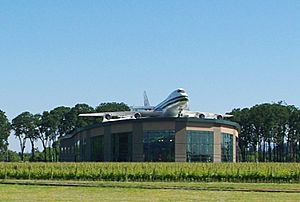
Exterior of the waterpark, showing the mounted Boeing 747-100.
The Wings & Waves Waterpark opened on June 6, 2011. It's Oregon's largest waterpark, covering 71,350 square feet! It has 10 slides and a wave pool. The waterpark also connects to the museum's educational goals. It has a "Life Needs Water" science center for kids. The four biggest slides start inside a real, retired Boeing 747-100 plane! This plane sits on the roof, 62 feet above the splash landing.
Another Boeing 747, a 747-200 model, is also displayed across from the museum building. It was first delivered to Singapore Airlines in 1973. It flew for several airlines before Evergreen International Airlines got it in 1995. It was retired and given to the museum in 2013.
In April 2020, The Stoller Group bought the land that included the museum buildings and water park. They plan to fix up the water park and build a 90-room hotel nearby.
Amazing Aircraft and Spacecraft

The instrument panel of an SR-71 Blackbird.
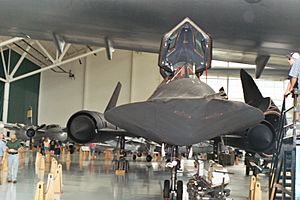
An SR-71 Blackbird under the wing of the Spruce Goose (before it moved to the new space building).
The museum has a fantastic collection of aircraft and spacecraft. Here are just a few highlights:
Aircraft Collection
The museum displays many different types of aircraft. These include:
- The unique Avtek 400A.
- Small planes like the Bede BD-5B Micro and Beechcraft Model 17.
- Military aircraft such as the Beechcraft T-34B Mentor and two Bell UH-1 Iroquois helicopters (nicknamed "Hueys").
- A Bell AH-1 Cobra helicopter that saw combat in Vietnam.
- A Cessna O-2 Skymaster with a famous history from the Rescue of Bat 21 Bravo.
- Large planes like the Consolidated PBY Catalina (a Canadian-made Vickers Canso) and the Douglas A-26C Invader.
- Famous transport planes like the Douglas C-47 Skytrain, which took part in D-Day and other World War II missions.
- The second oldest surviving Douglas DC-3A, which flew millions of passenger miles.
- Jet fighters like the Fairchild Republic A-10 Thunderbolt II, Grumman F-14 Tomcat, and Lockheed F-104 Starfighter.
- The stealthy Lockheed F-117 Nighthawk, which is being restored.
- The incredibly fast Lockheed SR-71A Blackbird.
- Many F-15 Eagle and McDonnell Douglas F-4 Phantom II jets.
- Russian-designed jets like the Mikoyan-Gurevich MiG-15, Mikoyan-Gurevich MiG-17, Mikoyan-Gurevich MiG-21MF, and Mikoyan MiG-29.
- Historic planes like the North American F-86H Sabre and North American F-100 Super Sabre.
- World War II trainers like the Ryan PT-22 Recruit and Stearman PT-17 Kaydet.
- A replica of the Wright Flyer, the first successful airplane.
The museum also has many aircraft engines and other helicopters.
Spacecraft Collection
The space building features impressive items like:
- A Foton-6 Space Capsule.
- The huge Martin Titan II SLV Space Launch Vehicle. This is the last of its kind that was built but never launched! Its exhibit includes the actual launch control equipment.
- A Titan IV launch vehicle, one of only two left in the world.
- A Mercury Space Capsule.
- The NASA X-38 V-131R, a test vehicle for a future crew return craft.
- A PGM-11 Redstone missile.
- A full-scale wooden model of the North American X-15 rocket plane.
Images for kids
-
The instrument panel of an SR-71 Blackbird.
-
An SR-71 Blackbird under the wing of the Spruce Goose (before it moved to the new space building).

